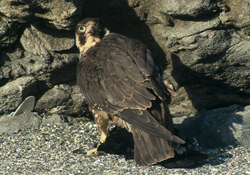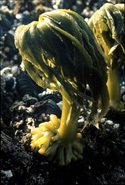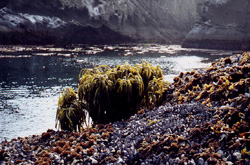 Although much of my research is on the consequences of extinction, I am also interested in increasing our understanding of the causes of extinction. My work in this area involves two general projects. One project was to develop a population viability model for Peregrine Falcons (Falco peregrinus) to explore whether populations would recover once the program of captive introductions was terminated (Wootton and Bell 1992). This analysis highlighted the importance of source-sink structure and its associated management implications, suggested that critical negative impacts on adult portions of the lifecycle have been overlooked, illustrated the difficulty of determining whether species are self-sustainable in the presence of population supplementation programs, and provided recommendations for the key data needed to ascertain population viability. Follow-up work has tested how well population viability models predict the future population trajectories of target species, using the Peregrine Falcon model as a case study (Wootton and Bell 2014).
Although much of my research is on the consequences of extinction, I am also interested in increasing our understanding of the causes of extinction. My work in this area involves two general projects. One project was to develop a population viability model for Peregrine Falcons (Falco peregrinus) to explore whether populations would recover once the program of captive introductions was terminated (Wootton and Bell 1992). This analysis highlighted the importance of source-sink structure and its associated management implications, suggested that critical negative impacts on adult portions of the lifecycle have been overlooked, illustrated the difficulty of determining whether species are self-sustainable in the presence of population supplementation programs, and provided recommendations for the key data needed to ascertain population viability. Follow-up work has tested how well population viability models predict the future population trajectories of target species, using the Peregrine Falcon model as a case study (Wootton and Bell 2014).
 An ongoing project is experimentally exploring the relative roles of key processes in elevating extinction risk in small populations in a field setting. Recently there has been a tension between emphasizing genetic mechanisms that may promote extinction (inbreeding depression, loss of favorable alleles via genetic drift) versus ecological/demographic processes (demographic stochasticity, Allee effects/positive density dependence in small populations, environmental stochasticity). Understanding the roles of these processes is essential for developing effective recovery strategies for endangered species, as they suggest very different management strategies (e.g., methods to increase genetic diversity vs. to increase population size). To our knowledge, no experimental studies of field-living populations exposed to all relevant processes have been undertaken to tease apart these effects.
An ongoing project is experimentally exploring the relative roles of key processes in elevating extinction risk in small populations in a field setting. Recently there has been a tension between emphasizing genetic mechanisms that may promote extinction (inbreeding depression, loss of favorable alleles via genetic drift) versus ecological/demographic processes (demographic stochasticity, Allee effects/positive density dependence in small populations, environmental stochasticity). Understanding the roles of these processes is essential for developing effective recovery strategies for endangered species, as they suggest very different management strategies (e.g., methods to increase genetic diversity vs. to increase population size). To our knowledge, no experimental studies of field-living populations exposed to all relevant processes have been undertaken to tease apart these effects.
 My colleagues (Cathy Pfister, Dick Hudson and Handojo Kusumo) and I are doing so with a uniquely well-suited intertidal kelp species, the sea palm Postelsia palmaeformis. This species is an annual that has extremely short offspring dispersal (on the scale of a meter), which allows implementation and maintenance of different genetic treatments (completely inbred [single founder], crossed with multiple individuals from the same source population, outcrossed with individuals from multiple regional populations) independent of different ecological treatments (high/low population size). We are following detailed performance of individuals within experimental populations, in concert with the genetic dynamics of the founder lineages, and will be integrating genetic and ecological effects into a detailed individual-based modeling framework to project extinction impacts. We find strong effects of demographic processes, but minor effects of genetic diversity (Wootton and Pfister 2013). In
My colleagues (Cathy Pfister, Dick Hudson and Handojo Kusumo) and I are doing so with a uniquely well-suited intertidal kelp species, the sea palm Postelsia palmaeformis. This species is an annual that has extremely short offspring dispersal (on the scale of a meter), which allows implementation and maintenance of different genetic treatments (completely inbred [single founder], crossed with multiple individuals from the same source population, outcrossed with individuals from multiple regional populations) independent of different ecological treatments (high/low population size). We are following detailed performance of individuals within experimental populations, in concert with the genetic dynamics of the founder lineages, and will be integrating genetic and ecological effects into a detailed individual-based modeling framework to project extinction impacts. We find strong effects of demographic processes, but minor effects of genetic diversity (Wootton and Pfister 2013). In  the process, we have developed AFLP and microsatellite markers for this species (Kusumo et al. 2004), and have documented extremely strong population genetic structure of very short scales, consistent with a extremely low dispersal pattern (Kusumo et al. 2006). We are also exploring similar questions in a series of isolated populations of the coastal fawn lily (Erythronium revolutum) found on Tatoosh Island.
the process, we have developed AFLP and microsatellite markers for this species (Kusumo et al. 2004), and have documented extremely strong population genetic structure of very short scales, consistent with a extremely low dispersal pattern (Kusumo et al. 2006). We are also exploring similar questions in a series of isolated populations of the coastal fawn lily (Erythronium revolutum) found on Tatoosh Island.
This research was funded by the National Science Foundation, OCE #01-17801, DEB #09-19420
